Two Stroke Engines
Atwo strokeengine is a type of internal combustion engine which completes a power cycle with two strokes of the piston during only one crankshaft revolution.
In four stroke engines, there is one working stroke in two revolutions of the crankshaft or in a cycle of four strokes of the piston. The desire of one working stroke in every revolution of the crankshaft has led to the development of two stroke engine .
In 1838, Barnett, an Englishman, described the mechanism for supplying a charge to the cylinder by means of separate pumps. In 1878, Dugald Clerk also made a lot of contribution in this direction and described a two stroke cycle known as Clerk Cycle.
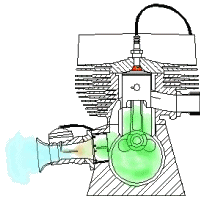
The two-stroke engine employs for small powers required in autocycles, scooters, motorcycles. In two-stroke engines, there is no suction and exhaust strokes. There are only two remaining strokes the compression stroke and power stroke. These are usually called the upward stroke and downward stroke. Also, instead of valves, there are inlet and exhaust ports in two-stroke engines.
Fresh charge enters the cylinder at the end of the working stroke through the inlet port. And then burnt exhaust gases are forced out through the exhaust port by a fresh charge.
Two strokes Spark Ignition (Petrol) Engine.
The principle of two stroke spark ignition engine is shown in the figure. Its two strokes are as follows:
- Upward Stroke
- Downward Stroke
Upward Stroke
During upward stroke, the piston moves upward from the bottom dead centre to top dead centre. By compressing the charge air petrol mixture in the combustion chamber of the cylinder. Due to upward movement of the piston, a partial vacuum is created in the crankcase.
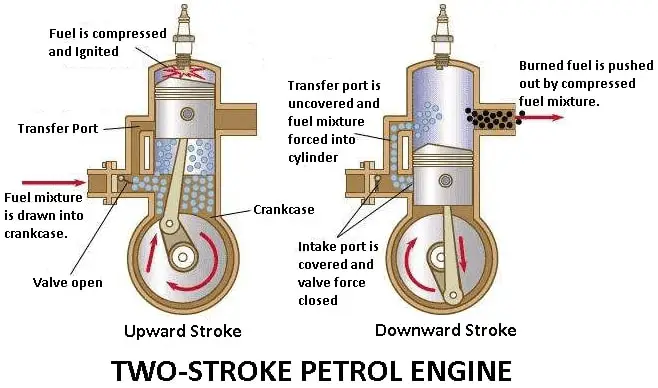
And a new charge is drawn into the crankcase through the uncovered inlet port. The exhaust port and transfer port are covered when the piston is at the top dead centre position. The compressed charge is ignited in the combustion chamber by a spark given by the spark plug.
Downward Stroke
As soon as the charge is ignited the hot gases compress the piston which moves downward, rotating the crankshaft thus doing the useful work. During this stroke, the inlet port is covered by the piston and the new charge is compressed in the crankcase. Further downward movement of the piston uncovers first the exhaust port and then the transfer port. and hence the exhaust starts through the exhaust port.
As soon as transfer port is open, the charge through it is forced into the cylinder. The charge strikes the deflector on the piston crown, rises to the top of the cylinder and pushes out most of the exhaust gases. The piston is now at the bottom dead centre position.
The cylinder is completely filled with a fresh charge, although it is somewhat with the exhaust gases. The cycle of events is then repeated, the piston making two strokes for each revolution of the crankshaft.

The figure shows a port diagram for a two stroke petrol engine. which is self-explanatory.
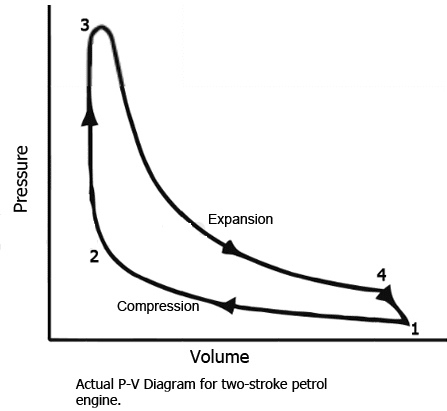
A figure shows the shape of the p-v diagram for a two stroke petrol engine. This diagram is only for the main cylinder or top side of the piston.
Two Stroke Compression Ignition (Diesel) Engine
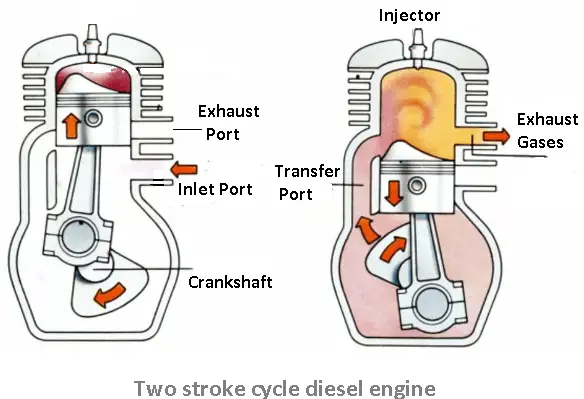
In this two stroke engine, only air is compressed inside the cylinder. and the fuel (diesel) is injected by an injector fitted in the head of the cylinder. There is no spark plug in this engine. The remaining operations of the two stroke compression ignition engine are exactly the same. as those of the spark ignition engine.
Port timing diagram for a two stroke diesel engine.

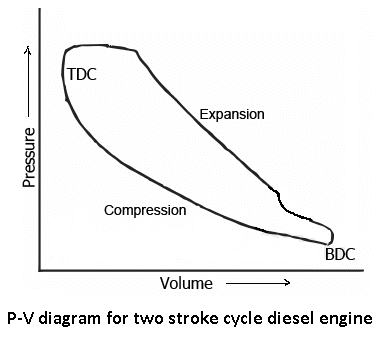
The figure shows the cylinder pressures and temperatures acting on spark plug for two strokes and four stroke engines.
Advantages of Two-Stroke Engine Over Four Stroke:
- The two stroke engine gives one working stroke for each revolution of the crankshaft. The four-stroke gives one working stroke for every two revolutions of the crankshaft. Hence, the power developed by two stroke engine is twice that developed by four-stroke engine for the same engine speed and cylinder volume.
- The turning moment on the crankshaft is more even in two stroke engine. Due to one working stroke for each revolution of the crankshaft, and so it need a lighter flywheel in it.
- For the same power, a two stroke engine is more compact, light and requires less space than a four-stroke engine. Thus it is more suited for auto-cycle, motorcycles and scooters.
- A two stroke engine is simpler in construction and mechanism. There is no valve and valve mechanism in it. The ports are easy to design and they are cover and uncover by the movement of the piston itself.
- It has high mechanical efficiency due to the absence of cams, crankshaft and rockers, etc., of the valves.
- It gives less torsional oscillations.
- Two stroke engine requires fewer spare parts due to its simple design.
- It can be reversed if it is of valveless type.
- There is a saving in work required to overcome the friction of the inlet and exhaust port.
Disadvantages
- In two stroke cycle Otto engine, the fuel consumption is high. because the fresh charge is likely to be wasted by escaping through the exhaust port.
- The actual compression starts when the ports are completely closed by the upward movement of the piston, after a few degree revolutions of the crankshafts. Thus, the actual compression ratio and hence the thermal efficiency of two stroke engine is less than that of the four-stroke for the same dimensions.
- The charge is diluted by the burnt gases due to incomplete scavenging.
- It gives greater noise.
- It consumes more lubricating oil.
- There are greater wear and tear of moving parts.
Comparison Between The Four-Stroke Engine and The Two-Stroke Engine.
| Four Stroke Engine | Two Stroke Engine |
| In four-stroke engine, one working stroke for every two revolutions of the crankshaft. | In this one working stroke for each revolution of the crankshaft. |
| The turning moment on the crankshaft is not even due to one working stroke for every two revolution of the crankshaft. hence it requires heavy flywheel and the engine runs unbalanced. | The turning moment on the crankshaft is more even due to one working stroke for each revolution of the crankshaft. Hence it requires lighter flywheel and the engine runs balanced. |
| The engine is heavy | The engine is light. |
| Cost of the engine is high | Cost of the engine is low. |
| Less mechanical efficiency due to more friction in many parts of the four stroke engine. | Mechanical efficiency is more due to less friction in a few parts. |
| The output is more due to full fresh charge intake and full burnt gases exhaust. | The output is low due to the mixing of fresh charge with the burnt gases. |
| The engine runs at cold | The engine runs at hot. |
| It is water cooled | It is air-cooled. |
| Less fuel consumption in the four stroke engine | Fuel consumption is more. |
| The engine requires more space | The engine requires less space. |
| Lubricating system is complicated | Lubricating system is simple. |
| The engine produces less noise | Noise is more. |
| The engine is used in cars, buses, trucks. | The engine is used for mopeds, scooters, motorcycles. |
| The engine consists of inlet and exhaust valves. | The engine is consists of inlet and exhaust ports. |
| More thermal efficiency. | Low thermal efficiency. |
| The engine consumes less lubricating oil. | These engines consume more lubricating oil. |
| Less wear and tear of moving parts in the engine. | Greater wear and tear of moving parts. |
Download Pdf of this article

If you like the article please share with your friends. Have any question regarding this topic feel free to leave a comment we will respond.
Images in this blog are from britannica.com, cycleworld.com
Source: https://www.theengineerspost.com/two-stroke-cycle-engine/
Posted by: elaelamafuae0271195.blogspot.com
Post a Comment